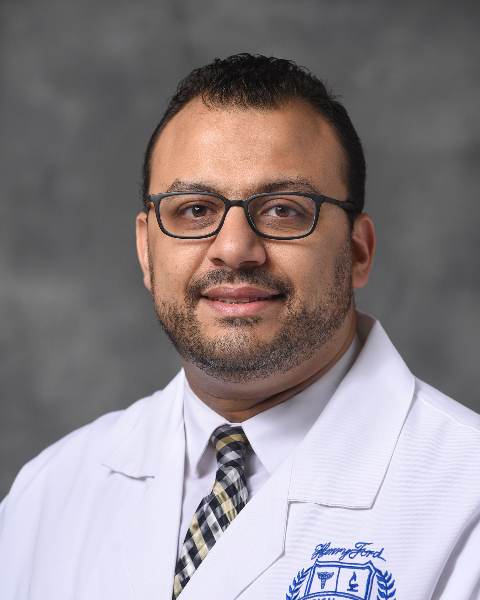PQA 03 - PQA 03 Gynecological Cancer, Pediatric Cancer, and Professional Development Poster Q&A
3503 - The Role of Adjuvant Radiotherapy and Chemotherapy for Surgically Staged Non-Myoinvasive Uterine Serous Carcinoma with Negative Peritoneal Washings
Monday, September 30, 2024
8:00 AM - 9:00 AM ET
Location: Hall C
Screen: 10

Ahmed Ghanem, MD, PhD
Henry Ford Cancer Institute/Alexandria University
Detroit, MI
Presenter(s)
A. I. Ghanem1,2, I. Aref3, C. H. Lin4, R. Khalil-Moawad5, M. Elshaikh5, and M. A. Elshaikh3; 1Department of Radiation Oncology, Henry Ford Health, Detroit, MI, 2Alexandria Clinical Oncology Department, Alexandria University, Alexandria, Egypt, 3Department of Radiation Oncology, Henry Ford Cancer Institute, Detroit, MI, 4Department of Public Health Sciences, Henry Ford Health, Detroit, MI, 5Department of Radiation Oncology, Henry Ford Health-Cancer, Detroit, MI
Purpose/Objective(s): Uterine serous cell adenocarcinoma (USC) represents an aggressive subtype of uterine carcinoma with poor survival especially if peritoneal washings have positive cytology. However, patients with stage I non-myoinvasive USC carry a better prognosis with controversial role for adjuvant therapies. We evaluated the survival impact of various adjuvant approaches for women with non-myoinvasive USC who had negative peritoneal washings. Materials/
Methods: We queried our uterine cancer database for patients with 2009 FIGO stage I non-myoinvasive USC who underwent hysterectomy with negative peritoneal washings at our institution between 1/1990-1/2023. Patients with synchronous malignancies and those with positive peritoneal cytology were excluded. We compared clinicopathological characteristics as well as survival endpoints using Kaplan-Meier curves and log-rank test based on patients’ receipt of any adjuvant treatment.
Results: Eighty-nine patients were included with a median age (interquartile range (IQR)) of 66 (62-72) years and a median (IQR) follow-up of 6.9 (5.9-9.2) years. The disease was confined to a polyp in 40% and 5.6% had lymphovascular space invasion. Omentectomy, pelvic and paraaortic lymph node (LN) surgical evaluation were performed in 65%, 84% and 43% of patients, respectively; with a median (IQR) retrieved LNs of 9 (2-22). 44 patients (49.4%) received adjuvant treatment: 27% radiation therapy (RT) plus chemotherapy (CT), 10% RT alone and 12.4% CT alone; and 45 patients (50.6%) were managed with surveillance. RT modalities utilized were vaginal cuff brachytherapy in 24/33, pelvic external beam RT in 4/33 and 5/33 received a combination. CT was 4-6 cycles of carboplatin and paclitaxel, whereas surveillance encompassed regular follow-up visits with examination, imaging and biopsies as needed. Surveillance patients were older than adjuvant therapies recipients: median (IQR) age 68 (63-74) vs 65 (60-68), respectively (P=0.01). Eleven patients (12.4%) were diagnosed with disease recurrence mainly distant. For patients who were managed with surveillance, compared to those who received adjuvant therapies, there was no statistically significant difference in 5-year recurrence-free (RFS) (78.2% (95% confidence interval (CI):65.8-93.1) vs 91.4% (CI: 82.5-100); P=0.08), disease-specific (DSS) (85.4% (74.4-98.2) vs 97% (91.3-100); P=0.1) and overall (OS) (83.3% (CI: 71.9-96.5) vs 92.1% (CI: 84-100); P=0.46) survival, respectively. The site of first recurrence pattern was non-different across both groups. On multivariate analyses, Charlson comorbidity burden independently predicted worse RFS (P=0.011) and OS (P=0.039), whereas tumor confined to polyp was associated with better RFS (P=0.043) and DSS (P=0.05).
Conclusion: For surgically staged patients with non-myoinvasive USC, and negative peritoneal washings, our study suggests that surveillance is a viable adjuvant option and should be discussed with similar patients, especially older ones.
Purpose/Objective(s): Uterine serous cell adenocarcinoma (USC) represents an aggressive subtype of uterine carcinoma with poor survival especially if peritoneal washings have positive cytology. However, patients with stage I non-myoinvasive USC carry a better prognosis with controversial role for adjuvant therapies. We evaluated the survival impact of various adjuvant approaches for women with non-myoinvasive USC who had negative peritoneal washings. Materials/
Methods: We queried our uterine cancer database for patients with 2009 FIGO stage I non-myoinvasive USC who underwent hysterectomy with negative peritoneal washings at our institution between 1/1990-1/2023. Patients with synchronous malignancies and those with positive peritoneal cytology were excluded. We compared clinicopathological characteristics as well as survival endpoints using Kaplan-Meier curves and log-rank test based on patients’ receipt of any adjuvant treatment.
Results: Eighty-nine patients were included with a median age (interquartile range (IQR)) of 66 (62-72) years and a median (IQR) follow-up of 6.9 (5.9-9.2) years. The disease was confined to a polyp in 40% and 5.6% had lymphovascular space invasion. Omentectomy, pelvic and paraaortic lymph node (LN) surgical evaluation were performed in 65%, 84% and 43% of patients, respectively; with a median (IQR) retrieved LNs of 9 (2-22). 44 patients (49.4%) received adjuvant treatment: 27% radiation therapy (RT) plus chemotherapy (CT), 10% RT alone and 12.4% CT alone; and 45 patients (50.6%) were managed with surveillance. RT modalities utilized were vaginal cuff brachytherapy in 24/33, pelvic external beam RT in 4/33 and 5/33 received a combination. CT was 4-6 cycles of carboplatin and paclitaxel, whereas surveillance encompassed regular follow-up visits with examination, imaging and biopsies as needed. Surveillance patients were older than adjuvant therapies recipients: median (IQR) age 68 (63-74) vs 65 (60-68), respectively (P=0.01). Eleven patients (12.4%) were diagnosed with disease recurrence mainly distant. For patients who were managed with surveillance, compared to those who received adjuvant therapies, there was no statistically significant difference in 5-year recurrence-free (RFS) (78.2% (95% confidence interval (CI):65.8-93.1) vs 91.4% (CI: 82.5-100); P=0.08), disease-specific (DSS) (85.4% (74.4-98.2) vs 97% (91.3-100); P=0.1) and overall (OS) (83.3% (CI: 71.9-96.5) vs 92.1% (CI: 84-100); P=0.46) survival, respectively. The site of first recurrence pattern was non-different across both groups. On multivariate analyses, Charlson comorbidity burden independently predicted worse RFS (P=0.011) and OS (P=0.039), whereas tumor confined to polyp was associated with better RFS (P=0.043) and DSS (P=0.05).
Conclusion: For surgically staged patients with non-myoinvasive USC, and negative peritoneal washings, our study suggests that surveillance is a viable adjuvant option and should be discussed with similar patients, especially older ones.
